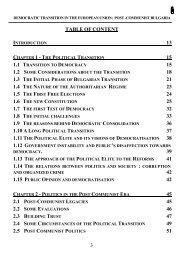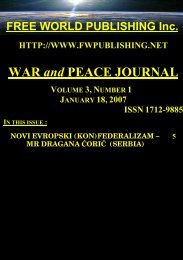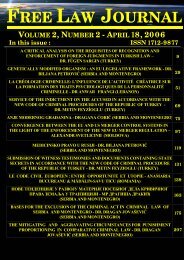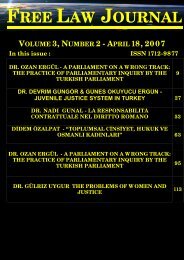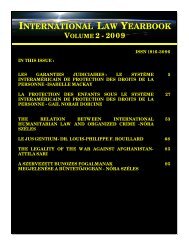Free_Law_Journal-Vol.. - Free World Publishing Inc.
Free_Law_Journal-Vol.. - Free World Publishing Inc.
Free_Law_Journal-Vol.. - Free World Publishing Inc.
You also want an ePaper? Increase the reach of your titles
YUMPU automatically turns print PDFs into web optimized ePapers that Google loves.
FREE LAW JOURNAL - VOLUME 1, NUMBER 1 (18 JULY 2005)<br />
assumed that the content of the judgement is true. A contentious subject should not be discussed more<br />
than one time, because different decisions given about one contentious issue can harm public conscience<br />
and it is against the procedural economy 6 .<br />
Res iudicata, bars a later claim because the issue definitely comes to a conclusion before the court 7 and it<br />
shows that the claim is extinguished and the fact is revealed 8 . By the extinction of the action, a new<br />
situation is formed and both parties of the action must respect this new situation. If the plaintiff, loses the<br />
action because of not obeying some formal provisions while bringing the action, but then wishes to bring<br />
a new action after correcting these discords, praetor 9 does not grant him the right to bring the second<br />
action. This means that praetor refuses the plaintiff’s claims. Besides praetor can grant an action to the<br />
plaintiff but in the same time he also grants an exceptio rei iudicata in favour of the defendant which<br />
makes the plaintiff’s action senseless 10 .<br />
Bis de eadem re ne sit actio principle and definite judgement are directly related with the cultiminating<br />
effect of the joinder of issue (litis contestatio) 11 . As it is known, especially in formulary system, the litis<br />
contestatio phase carries an important role. It extinguishes the claim sued on and replaces it by a right to<br />
have the question as formulated, decided by the judge (iudex). During the prosecution of an action, when<br />
joinder of issue phase is completed, it is accepted that contentious issue between the parties comes to an<br />
end and this contentious issue can not be brought before a court subsequently 12 . The aim of bis de eadem<br />
re ne sit actio principle is, in a way gained by completing the joinder of issue phase in formulary<br />
procedure, because this produces the same results with res iudicata in some conditions.<br />
Joinder of issue phase can be accepted as an agreement made by the parties of the action. But it is not<br />
done under the control of praetor. By conclusion of joinder of issue phase, the subject of the action<br />
becomes this agreement. In formulary system of Roman procedural law, after completing joinder of issue<br />
phase of an action, the possibility of bringing another action 13 or forming a new joinder of issue with<br />
reference to the same contentious issue, ends 14 .<br />
recuperatores hear different actions. They are common in the court of preator peregrinus but they are sometimes employed by<br />
praetor urbanus.<br />
5 Stephenson, A.; A History of Roman <strong>Law</strong> with a Commentary on the Institutes of Gaius and Justinian, Colorado, 1992, p. 200<br />
sq.; Tahiroglu, B./ Erdogmus, B.; Roma Hukuku Meseleleri, Istanbul, 2001- Some Matters in Roman <strong>Law</strong>, p.195, (Matters).<br />
6 Thomas, p. 319; Roby, H. J.; Roman Private <strong>Law</strong> in the Times of Cicero and of the Antonines, Cambridge, 1902, p. 259;<br />
Tahiroglu/ Erdogmus, (Matters), p.194.<br />
7 D. 3, 3, 40, 2.<br />
8 Muirhead, J.; Historical Introduction to the Private <strong>Law</strong> of Roman, 3. Ed., Rev. and Ed. by Henry Goudy, London, 1912, p.<br />
90; Umur, Z.; Roma Hukuku Lugatı, Istanbul, 1985- Roman <strong>Law</strong> Dictionary, p. 181-2, (Dictionary); The judge, while giving<br />
the judgement, takes into consideration res in iudicium (D. 1, 5, 25; D. 42, 1, 1).<br />
9 Schulz, F.; Classical Roman <strong>Law</strong>, Oxford, 1951, p. 13; The jurisdictional magistrate within the limits of the Rome and boths<br />
parties are Roman citizens, is called praetor urbanus; if one or both are non- Romans the jurisdictional magistrate is called<br />
praetor peregrinus.<br />
10 Tahiroglu, B. / Erdogmus, B.; Roma Usul Hukuku, Istanbul 1994- Roman Procedural <strong>Law</strong>, p. 28, (Procedure).<br />
11 Schulz, p. 14; The term litis contestatio is used to designate the end of the proceeding in iure and even this proceeding as a<br />
whole.<br />
12 Wenger, p.104; Frezza, P.; Le Garanzie delle Obbligazioni, Le Garanzie Personali, V. I, Padova 1963, p. 311, The changes<br />
which occurred on the subject of the action after joinder of issue phase, are no longer taken into consideration. They can only<br />
be subject of another action. “D. 5, 1, 23, Paul. 7 ad Plaut.; Non potest videri in iudicium venisse id quod post iudicium<br />
acceptum accidisset : ideoque alia interpellatione opus est”. “Obligatio operarum which are not requested from the plaintiff<br />
before the end of litis contestio phase, can not be gauged in this action.<br />
13 “Gai. 3, 180; Tollitur adhuc obligatio litis contestatione, si modo legitimo iudicio fuerit actum nam tunc obligatio quidem<br />
principalis dissolvitur, incipit autem teneri reus litis contestatione; An obligation is also extinguished by a joinder of issue,<br />
provided the action brought is authorized by law, for then the original obligation is dissolved, and the defendant begins to held<br />
GOKCE TURKOGLU-OZDEMIR - “BIS DE EADEM RE NE SIT ACTIO” PRINCIPLE IN THE FORMULARY SYSTEM OF ROMAN LAW OF PROCEDURE 142






